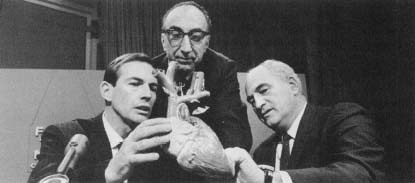Barnard, Christiaan N.
Robert K. Jarvik's experiments with artificial heart transplants followed Christiaan Barnard's (1922-) pioneering work in human heart transplantation. Barnard rose to international prominence when he performed the world's first human heart transplant at Groote Schuur Hospital in Cape Town, South Africa, on December 3, 1967. Fifty-five-year-old Louis Washkansky, recipient of the first transplanted heart—that of a young woman who became brain dead following an auto accident but whose heart was still beating—recovered well enough to sit up in bed and eat steak and eggs. But eighteen days after his surgery he died of double pneumonia. His immune system, suppressed by drugs and radiation so pneumonia would not attack his new heart, had been unable to fight the infection.
The doctor who performed this revolutionary surgery had been interested in transplant procedures for much of his career. Barnard was born and raised in the South African countryside. Known for his excellent academic

Barnard's heart transplant surgery opened a host of ethical questions, which were widely discussed in forums such as newspapers and magazines. The initial enthusiasm for heart transplant surgery faded quickly, not over ethical quandaries, but because heart recipients continued to succumb to infection. Amid criticism that he had rushed too hastily into a risky procedure, Barnard continued to perform and perfect the transplant procedure. As the operation became more routine, more patients survived longer. By 1983 over sixty-three heart transplants had been done at Groote Schuur under Barnard's direction (including a 1974 double-heart transplant, in which Barnard implanted the heart of a ten-year-old girl in the body of a fifty-year-old man without removing the man's diseased heart).
Comment about this article, ask questions, or add new information about this topic: